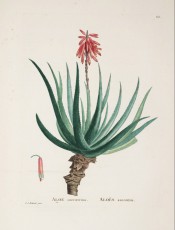Aloe succotrina Lam.
Aloe with stems to 1.2m, the leaves gradually tapering, pale coloured or glaucous with small white teeth and sometimes blotched at the base, the flowers red in a loose spike, to 30cm high. [RHSD, Hortus].
Horticultural & Botanical History
First botanically described by Lamarck in 1783 [Encyclopédie méthodique. Botanique vol.1, p.85/1783].
‘The figure here given was drawn in January 1799, from a plant in full bloom in the dry stove of the Apothecaries Garden at Chelsea; Mr. Fairbairn informs me that it flowers regularly every year: the plant itself, supposed to be fifty years old, has a stem the thickness of one's arm, naked for the space of about four feet from the ground, then dividing into several large heads, formed of the leaves growing in clusters, from the centre of which arise the flowering-stems, two feet or more in length, producing spikes of flowers frequently much longer than those represented on the plate; these before they open are upright, when fully blown they hang down, and when out of bloom they turn upwards. This undoubtedly is the Aloe vera of Miller, and the perfoliata var. succotrina of Mr. Aiton, that which produces the Succotrine Aloes of the shops, and is said to grow in the Island of Zocotra or Socotora, in the Straits of Babelmandel; it is therefore highly interesting as a medicinal plant, and very desirable as an ornamental one. Is propagated by offsets, which it does not produce in any great plenty, and to have it in perfection, it must be treated as a dry-stove plant.’ [BM t.472/1799].
This species, whilst strongly associated with the island of Socotra off the Red Sea is thought to be originally a native of South Africa.
Extracts of Aloe have been used in medicine in Asia and Europe for centuries. ‘The name Aloe socotrina was undoubtedly derived from the island of Socotra, off the entrance to the Red Sea. Yet, some authors maintain that the name was by some given to the inspissated juice of aloe (succus citrinus), on account of the lemon-yellow color of its powder. Not all the earlier medico-pharmaceutical writers who afterwards considered the drug refer to socotrine, or any other special kind of aloes. Hieronymus Bock, 1556, merely alludes to the drug being brought from India and Arabia, a statement already found in Dioscorides. He relates an instance where the aloe plant is cultivated in Germany as an indoor ornamental plant, under the name sempervivum.
Samuel Purchas, however, in his important collection of travels, 1625, gives prominence to Socotrine aloes, and places on record the commercial transactions of British merchants with the king of Socotra.
One of his contributors, (William Finch, merchant), gives the following interesting information, which he gathered about 1607 A. D., concerning the preparation of aloes in the island of Socotra: “I could learne of no merchandise the iland yeeldeth, but Aloes, Sanguis Draconis, and Dates and, as they say on the shore of Aba del Curia, Blacke Ambergreese. Of Aloes I suppose they could make yearly more than Christendome can spend, the herbe growing in great abundance, being no other than Semper vivum, in all things agreeing to that description of Dioscorides in seed, stalke, etc. It is yet all of a red pricklie sort, and much chamfered in the leaves, so full of a resin-iuyce that it is ready to breake with it. The chiefe time to make it, is when the winds blowe northerly, that is, about September, and that after the fall of some raine, which being then gathered, they cut in small pieces, and cast into a pit made in the ground, well cleansed from filth and paved; there it lieth to ferment in the heat of the sunne, whereby it floweth forth. Thence they take and put it in skinnes, which they hang up in the wind to dry, where it becommeth hard. They sold us for 20 Rials a Quintall which is 103 pounds English, but we were after told that they sold to others for 12, which considering the abundance and easie making, may be credible.” [Lloyd - Origin and History of all the Pharmacopeial Vegetable Drugs, Chemicals and Preparations p.6/1921].
History at Camden Park
Aloe succotrina is marked with a ‘c’ in an 1836 edition of Loddiges’ catalogue held at Camden Park [CPA]. In William Macarthur’s code, used and explained elsewhere, this means grown at Camden. It is almost certain that it was grown in the gardens around this time but may have been short lived as it did not appear in the catalogues.
Notes
Published Apr 01, 2010 - 12:09 PM | Last updated Mar 05, 2012 - 04:58 PM
| Family | Aloaceae |
|---|---|
| Category | |
| Region of origin | South Africa, Cape district |
| Synonyms |
|
| Common Name | Socotora aloe |
| Name in the Camden Park Record |
Aloe succotrina |
| Confidence level | high |
